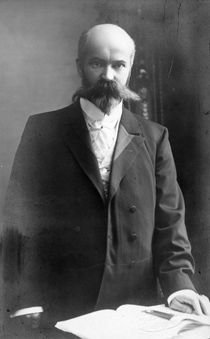

 Maksis Šervinskis
Maksis Šervinskis
Max Gustav Richard Scherwinsky was born on the 1st of November 1859 in Tilsit, East Prussia in the family of a country nobleman of Polish descent who had emigrated from Poland after the defeat of the uprising of 1832. After graduating from the Tilsit Grammar school and Buxtehude Construction technical school in 1879 Max Scherwinsky started studying architecture in the Württemberg Royal Polytechnic School in Stuttgart. Later, having moved to Riga, he worked as a teacher at Riga School for Crafts, taught drawing at the Riga Polytechnic, as well as Riga Lomonosov Girls' Gymnasium. Since 1888 he was the director of Riga School for Crafts. Among his students were painters Janis Rozentāls and Vilhelms Purvītis, as well as many future Latvian construction entrepreneurs, cabinetmakers and master craftsmen of other fields of applied art.
Alongside with his teaching work Max Scherwinsky was an active participant of various contests and craft exhibitions. In the Riga Craft Exhibition of 1883 he was awarded the bronze medal and in the All-Russian Exhibition of Industry and Arts of 1896 in Nizhni Novgorod – the silver medal. In 1899 together with the architect Alfred Aschenkampf Scherwinsky participated in the reconstruction of the house of book publisher Alexander Grosset at 7 Audēju Street – thus one of the first Art Nouveau buildings in Riga was built.
In 1900 Scherwinsky won the contest for providing the architectonic solution for Riga 700th anniversary exhibition: he was entrusted with the task of planning the layout of the exhibition and producing building projects. Stalls and pavilions for different companies were set up according to his projects. Scherwinsky created an exhibition of his own architectonic drawings and received a diploma and the gold medal for them.
Max Scherwinsky has written several textbooks for study purposes of craft school students. In 1902 he published a splendidly illustrated book on the Riga 700th Anniversary Exhibition – „Die Rigaer Jubilaeums - Ausstellung 1901 in Bild und Wort” (Riga Anniversary Exhibition 1901 In Pictures and Words).
In 1908 he celebrated 25 years of teaching. Among the anniversary presents there was his portrait, painted by his ex-pupil and later his friend Janis Rozentāls and a silver cup from school graduates.
In the summer of 1909 Scherwinsky went to the Arts and Crafts Exhibition in Stockholm. There he suddenly caught an illness, died on July 12 and was buried in the local cemetery. The students of Riga School for Crafts transferred his remains to Riga and buried him in the Great Cemetery. A few years later his students put up a gravestone with an inscription saying „To the beloved director from the grateful students of School for Crafts”.
Max Scherwinsy is one of those culture functionaries of the 19th - 20th century whose talents were incredibly multi-faceted. He has worked as an architect, a designer, also an artist. He has sketched designs for furniture and items of applied decorative art as well as painted watercolours of various towns and cities. His work as a teacher kept him up-to-date with new style tendencies and progressive technology.
Items designed by Max Scherwinsky perfectly depict the swift transition from the form language of eclectism to the brand new Art Nouveau forms in architecture and art. Therefore it is logical that a seat of honour among the pioneers of this new style in Riga belongs to the architect and artist Max Scherwinsky.